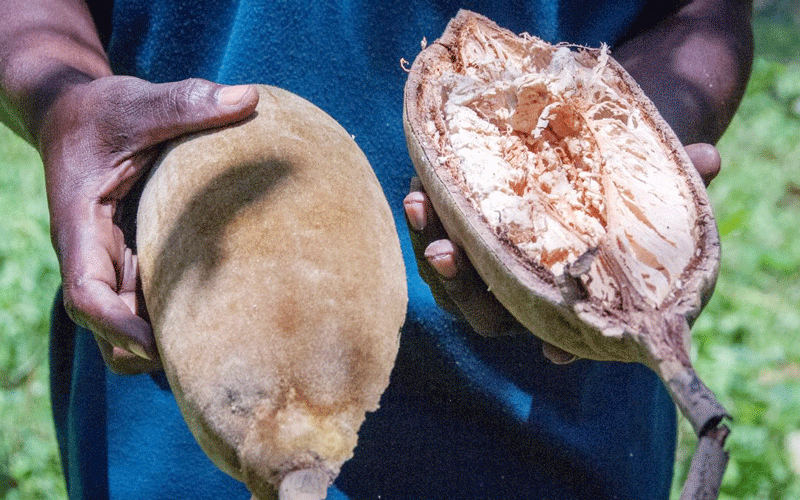
ZIMBABWE’S future is premised on the need to transform the nation’s heritage into sustainable income projects for communities, according to a new report.
This approach is encapsulated in the heritage-based Education 5.0 model, which aims to transform the education system to produce graduates capable of creating wealth and advancing national interests.
A report by ZimTrade, the country’s trade development and promotion organisation, noted that natural resources form part of the wider heritage-based products that are earmarked for economic transformation.
In fact, wild fruits play a significant role in this heritage-based innovation framework as many Zimbabwean communities rely on wild fruits for nutrition, medicine, among other many uses.
This is where wild fruits like baobab come in, the report notes.
The African baobab, scientifically known as Adansonia digitata, is an iconic tree found across the African continent. In Zimbabwe, the baobab tree is widespread, and its distribution is influenced by climatic conditions and habitat suitability.
The tree generally occurs in low-altitude areas within Zimbabwe. It thrives in hot and dry woodlands and the specific regions where baobabs are abundant including Zambezi Valley in Matabeleland, Mashonaland provinces, as well as Masvingo and Manicaland.
In Zimbabwe, the baobab tree grows in very dry areas, with rainfall of as little as 500 millimetres a year. The trees fruit in the middle of the dry season, when there is little else growing and few other income opportunities for local communities.
- Zimbabwe’s trade deficit narrows to US$179m
- Malawi warms up to Zim products
- ZimTrade targets African markets
- ZimTrade targets African markets.
Keep Reading
The baobab fruit is one of the most nutritious foods in the world and it is considered a super fruit. The fruit is considered a nutrient-dense fruit, and the pulp is particularly rich in vitamin C, and contains B vitamins, potassium, magnesium, iron, calcium, and fibre.
“For thousands of people in the dry lands of Zimbabwe, especially groups of women and youths, the fruit is an avenue for making an income, with households making incomes from the harvesting and selling of the baobab fruit,” the report reads in part.
Zimbabwe has an estimated five million baobab trees, with four million of the trees situated on communal lands. The fruit is seasonally available for harvest from April to September, and this signals the peak season for baobab fruit.
“For generations, the baobab fruit has been harvested and sold to local markets either as fruit with seed or as powder.
“In recent years, there has been a huge realisation that the baobab trees and its fruits are much more than a source of food for rural communities, but a cash crop that can provide huge returns,” ZimTrade said.
“With training and capacity interventions, the baobab fruit has presented huge potential for the commercialization of the baobab fruit and its by-products.”
ZimTrade has developed several products by small businesses and rural communities, where innovation has resulted in creation of export competitive products such as essential oils, and animal feed.
In Mudzi, ZimTrade is working with Camfed and Harare Institute of Technology to develop a processing plant that will allow a group of ten young women to process baobab into high end products.
The group has already participated at international trade fairs such as the Intra Africa Trade Fair, held in Egypt last year, where they engaged with leading buyers in the market who expressed sources from Zimbabwe.
“The group has sent sample orders to Egypt and once approved, the market will absorb much of the production coming from Mudzi, which will put the community on the national export map,” it said.
“Some of the current products from baobab fruit that have been developed for export include baobab powder, and baobab oil.
“Baobab powder is highly versatile and finds applications in various sectors, including food and beverages, nutraceuticals, and cosmetics, amongst other uses.”
Research by ZimTrade has shown that a kilogramme of baobab powder sells for between US$20 to US$40 at international markets, with the oil price much higher at between US$80 to over US$100 per litre.
Without processing, the 20-litre tin of cracked baobab is being sold for US$1 in some parts of Zimbabwe.
In terms of markets, Europe is a key importer of baobab powder due to its growing demand for natural health products. Baobab powder is marketed as a food supplement that supports immune health and overall well-being.
According to the Netherlands Enterprise Agency’s Centre for the Promotion of Imports from developing countries, the European market for baobab ingredients is expected to grow by 4% in the coming years.
Other studies put the expected compound annual growth rate at anything between 5,6% to 9,4%.










